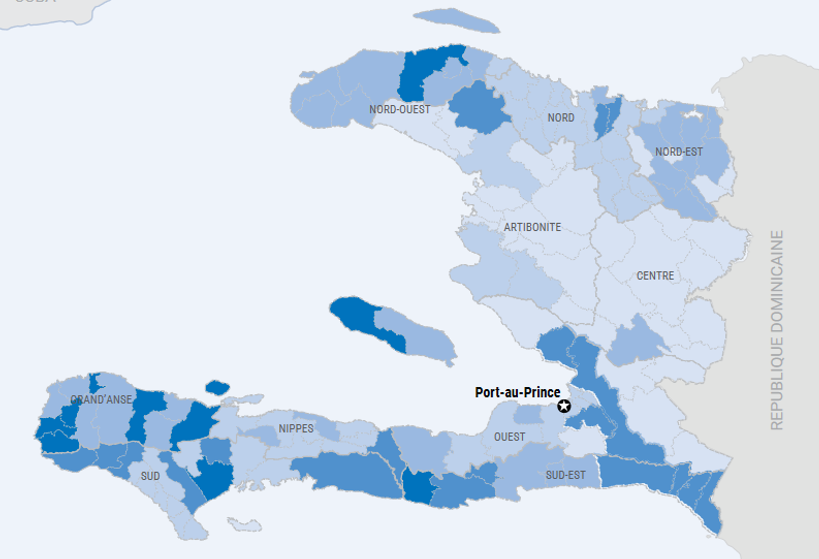
Haiti – Funding Briefing5 min read
Before August 2021, over 40% of the Haiti population required humanitarian assistance (4.4 million to be precise). The 2021 Humanitarian Response Plan (HRP) (published in March) responds to acute food insecurity and reduced access to services, such as health and water, hygiene and sanitation – but that was even before the events that were to unfold. A magnitude 7.2 earthquake on the 14th August 2021 affected 800,000 people, with 130,000 homes damaged and destroyed. Just over a month before, the President of Haiti was assassinated. And on top of this, there is growing gang violence, jeopardising the security of ordinary people and impacting humanitarian access.
The issue is that Haiti has been consistently underfunded over the past five years. In fact, as we found out in this story on Underfunded Crises, Haiti is the 2nd most underfunded humanitarian crisis.
Chronically underfunded
No matter how you analyse the figures, Haiti is one of the most underfunded contexts in the past five years.
First let’s look at it by ‘cumulative funding’ over the last five years. That’s the total dollar value of funding to all response plans between 2016 and 2020. Of the 25 contexts we analysed for the underfunded crises story, Haiti received the 3rd lowest amount of funding in the past five years for their response plans: $372m, or $74m on average per year. $372m seems like a lot until you compare it to the average context, which received $1.4bn across the last five years.
We could try to look at it another way. Maybe the dollar value is low because needs are low, right? Not really. Let’s look at the amount of funding over those five years, and divide it by the amount required over those five years. Overall, Haiti response plans were only cumulatively 30% met during that five year period. That’s the second lowest of all the contexts (behind only the DPRK), and far behind the average (57%).
The next obvious question might be, “so it’s underfunded in terms of monetary value, but maybe there’s a low amount of people in need, therefore funding per person could be high compared to other contexts?”. If only it were so. Haiti also has the second lowest yearly average spend per person in need – $24 per person. We’re talking about the median here – so if we have 5 years with 5 values, we are showing the middle value here. The average context has $78 of funding per person in need, and the Rohingya crisis in Bangladesh even has an average of $436 spent per person in need.
Lastly, could it be that funding isn’t classified as ‘response plan funding’ but broader humanitarian funding that isn’t in the scope of the response plan, or tagged as such? For those not accustomed to the distinction between the two, this is how OCHA define it: “We refer to…funding “outside the appeal” as all reported humanitarian funding not towards the Response plan/appeal, therefore outside the Humanitarian Response Plans (HRPs) activities or projects”. Even if we look at this metric, Haiti is the 5th lowest of all contexts, ahead of only DPRK, Burundi, Burkina Faso, and Libya. The Haiti total of $737m is someway behind the average (median) across contexts, which is $1.9bn across the five years.
Haiti is underfunded in absolute money terms, underfunded compared to how much funding is required, underfunded in terms of funding per person, and underfunded if you look inside or outside of the response plan.
Humanitarian sectors
And it’s not just the overall response that is underfunded, but individual sectors. In 2020, 5 out of the 8 humanitarian sectors in Haiti were funded below average. At the extreme end, Shelter had zero recorded funding for the Haiti response in 2020 (though that’s most likely an underreporting issue, we hope), compared to an average Shelter response in 2020 that was 19% funded.
Shelter wasn’t the only sector that benchmarked poorly in 2020 compared to the average. Education, Protection, Nutrition and Food Security all received less than the average percentage for their sectors.
The only sectors to break the 50% mark were Logistics, which received 64% of the funding requirement, and Health, which received 90% of the funding requirement (though in the year of the pandemic that might not be too surprising).
Things can, however, fluctuate year-on-year. So maybe 2021 will be better, right?
Behind the curve
At the time of writing (27th August 2021), the Haiti Humanitarian Response Plan (HRP) was the third least well-funded HRP of 2021 so far, with only 16% of funding received compared to funding required. This is in front of only Zimbabwe and Colombia, but behind the median response plan, which was 27% funded.
The Flash Appeal is another opportunity to bring in some much needed funding to Haiti. $187m is required to reach the targeted 500,000 persons affected by the Earthquake. The funding required is on top of the existing HRP, bringing the total funding required for Haiti to $423m for 2021.
Given that Haiti only received $372m in the past five years altogether, the $423m funding ask for Haiti this year is surely out of reach. The question is, how far will we fall short? And what are the human consequences of falling short by a bit, or by a lot?
Sources, References and Credits
All funding data was retrieved from the Financial Tracking Service (FTS). The first three graphs on the page all use data retreived on 1st and 2nd March 2021 – this is the same data used for the Underfunded Crises story. The fourth graph, on ‘inside’ or ‘outside’ response plans was retrieved on the 30th August 2021, as was the last graph. The fifth graph, focused on sectors, uses data retrieved from FTS on 6th May 2021 – this is the same data used for the ‘plan equity’ graphs on the different sector pages.
Credit: image taken from Haiti’s 2021 HNO and is an image of severity of humanitarian needs. Darker blues denote higher severity levels.
OCHA (2021). Haiti: Earthquake. Situation Report No.2. 26th August 2021. Retrieved from https://reliefweb.int/sites/reliefweb.int/files/resources/2021-08-26_OCHA_Haiti%20Earthquake_SitRep%232%20PDF.pdf
OCHA (2021). Flash Appeal Haiti. Earthquake August 2021. Retrieved from https://reliefweb.int/sites/reliefweb.int/files/resources/Haiti%20-%20Flash%20Appeal%20-%20Earthquake%20%28August%202021%29.pdf
OCHA (2021). Haïti : Plan de réponse humanitaire (HRP) 2021-2022. Retrieved from: https://www.humanitarianresponse.info/sites/www.humanitarianresponse.info/files/documents/files/hti_hrp_2021-2022_fr.pdf
OCHA (2021). Haïti : Haïti : Aperçu des besoins humanitaires (HNO) 2021. Retrieved from: https://www.humanitarianresponse.info/sites/www.humanitarianresponse.info/files/documents/files/hti_hno_2021-fr.pdf
The New Humanitarian (2021). Gang violence and security vacuum in Haiti thwart aid delivery. Retrieved from: https://www.thenewhumanitarian.org/news/2021/7/20/gang-violence-and-security-vacuum-in-haiti-thwart-aid-delivery


